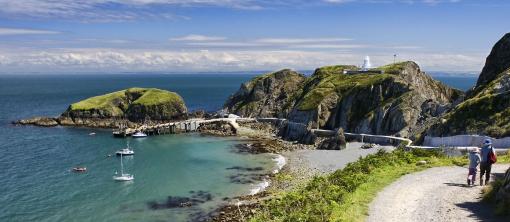 Lundy
Lundy
Lundy Island is in the Bristol Channel off the west coast of Devon. It attracts many visitors, both for its lovely and peaceful surroundings and for scientific research. The waters around Lundy are England’s only statutory Marine Nature Reserve. The island itself is mostly granite with some shale at the southern end. There is a farmed area to the south and open moorland to the north. It is three and a half miles long and half a mile wide, rising steeply from the Bristol Channel.
The island is home to a small range of mammals but hosts large numbers of resident and visiting birds. Many rare species have been recorded, particularly North American birds swept over the Atlantic. Several plant species are found only on Lundy. The Lundy Cabbage is one of about a dozen indigenous plants in the British Isles and is unique in having its own endemic insect, the Bronze Lundy Cabbage Flea Beetle which lives only on the plant. Of course Lundy is famous for its seabirds, especially for the puffins which gave the island its name (Lundy is Norse for Puffin Island). A few breeding pairs of these birds remain. There is also a wealth of other animals and plants both on the island and in the waters around.There is evidence of early human habitation on the island, including some Mesolithic flint work, Bronze Age burial mounds, an early medieval monastery, Victorian quarries and early modern artillery fortifications. Landmark Trust employs the present inhabitants who manage the farm and holiday accommodation. Lundy is owned by the National Trust.
There are many spectacular walks around this magnificent island to places with strange names such as Needle’s Eye, Rat Island, Shutter Point, Kittiwake Gully and Gannets Rock. The island has a history of piracy and smuggling interspersed with periods of peaceful habitation. During one of the latter periods, the rector was Thomas Heaven and the island was known as the Kingdom of Heaven! Many of the buildings such as the Old Lighthouse and even a 13th century castle provide accommodation for the welcome visitor. The castle was built by Henry III in 1244, paid for from the sale of rabbits, as Lundy was designated a Royal Warren. The walls of the small keep are three feet thick, constructed of local granite and inclining inwards. The castle was probably the main building on the island until the late 18th century. The Marisco Tavern is the central point of the island also providing food and shelter.
A day trip to Lundy is a chance to enjoy the beautiful North Devon coastline. From Ilfracombe or Bideford, the voyage takes about two hours on the island's own ship, the M.S. Oldenburg. Lundy lies where the Atlantic Ocean meets the Bristol Channel and there is nothing between this granite outcrop and America. It is a place apart, peaceful and unspoilt, where the visitor can enjoy such pursuits as walking, diving, bird watching, fishing, snorkelling, photography and painting.A three and a half mile long rock set menacingly in the middle of a busy shipping lane, Lundy has a dismal record of shipwrecks. In the 18th century, a group of Bristol merchants built a lighthouse at their own expense on Beacon Hill, the highest point on the island. The Old Light was designed and built in 1820 by Daniel Asher Alexander, the architect of Dartmoor prison. Connected to the tower by a passage were the quarters for the families of the keepers.
Lundy Marine Nature Reserve is a great place for divers. The clear waters are warmed by the Gulf Stream so that warm water species such as branching sponges, red sea fingers, sea fans and cup-corals, rarely found in British waters, can be seen in abundance here. Lundy also boasts countless shipwrecks that Lundy has claimed and divers also have encounters with the inquisitive grey seals that live around the island in the summer months. Some experienced divers have even snorkelled with basking sharks.

